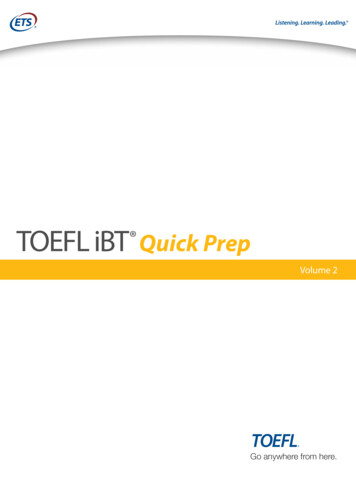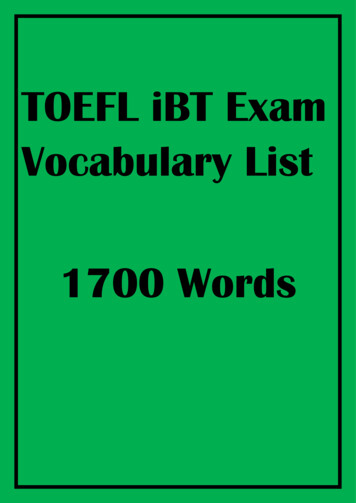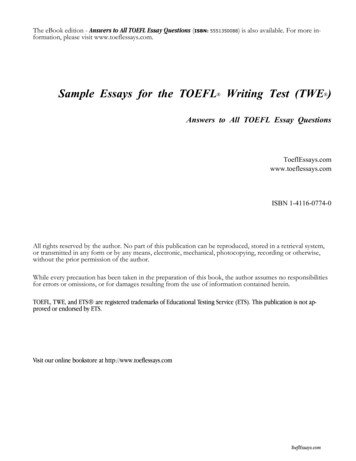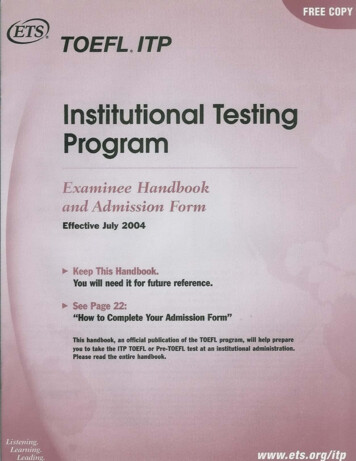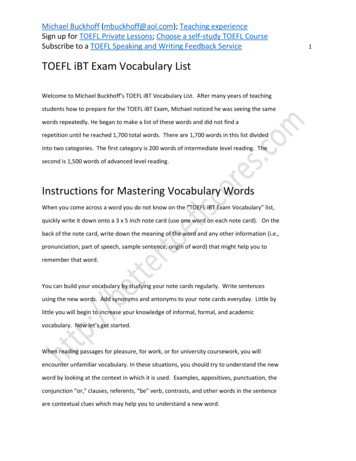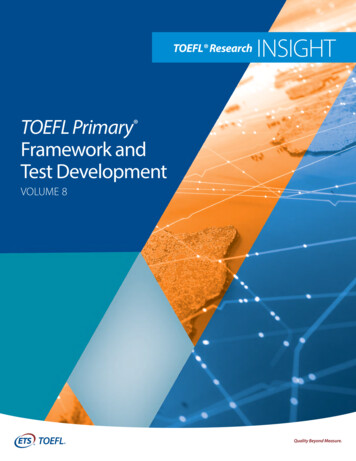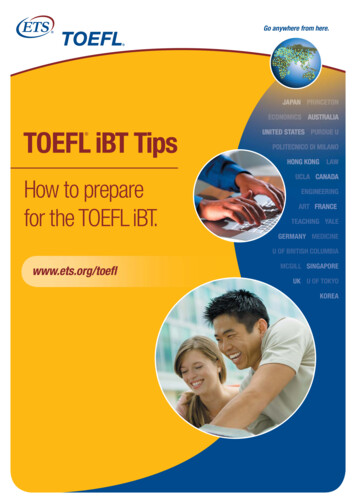
Transcription
Go anywhere from here. TOEFL iBT TipsHow to preparefor the TOEFL iBT.GERMANY MEDICINEU OF BRITISH COLUMBIAwww.ets.org/toeflMCGILL SINGAPOREUK U OF TOKYOKOREA
For the latest information about the TOEFL iBT or to sign upfor our mailing list to receive updates, visit www.ets.org/toefl.Contacts for Test Takers and Parents:Write to: toefl@ets.orgCall: 001-609-771-7100 (Outside of the United States, U.S. Territories and Canada)Call: Toll Free 1-877-863-3546 (Inside the United States, U.S. Territories and Canada)Contacts for Teachers and Institutions:Write to: toeflnews@ets.orgCall: 1-609-683-2008
TOEFL iBT TipsTOEFL iBT Tips—from ETS . . . . . . . . . . . . . . . . . . . . . . . . . . . . . . . . . . . 4Open More Doors with TOEFL iBT, the Key to Academic Success. . . 4Introduction . . . . . . . . . . . . . . . . . . . . . . . . . . . . . . . . . . . . . . . . . . . . . . . . 4The TOEFL Test—The Key to Academic Success . . . . . . . . . . . . . . . . . 4TOEFL Scores Open More Doors . . . . . . . . . . . . . . . . . . . . . . . . . . . . . . 4The New TOEFL iBT . . . . . . . . . . . . . . . . . . . . . . . . . . . . . . . . . . . . . . . . 4What’s New About the TOEFL iBT? . . . . . . . . . . . . . . . . . . . . . . . . . . . . 5Why Were Changes Made to the TOEFL Test? . . . . . . . . . . . . . . . . . . . . 5About the TOEFL iBT . . . . . . . . . . . . . . . . . . . . . . . . . . . . . . . . . . . . . . . . 6Overview . . . . . . . . . . . . . . . . . . . . . . . . . . . . . . . . . . . . . . . . . . . . . . . . . . 6Format . . . . . . . . . . . . . . . . . . . . . . . . . . . . . . . . . . . . . . . . . . . . . . . . . . . . 6Question Types . . . . . . . . . . . . . . . . . . . . . . . . . . . . . . . . . . . . . . . . . . . . . 7Toolbar . . . . . . . . . . . . . . . . . . . . . . . . . . . . . . . . . . . . . . . . . . . . . . . . . . . . 7A. TOEFL iBT Reading Section . . . . . . . . . . . . . . . . . . . . . . . . . . . . . . . . 8Academic Reading Skills . . . . . . . . . . . . . . . . . . . . . . . . . . . . . . . . . 8Description . . . . . . . . . . . . . . . . . . . . . . . . . . . . . . . . . . . . . . . . . . . . 8What is Different? . . . . . . . . . . . . . . . . . . . . . . . . . . . . . . . . . . . . . . . 10B. TOEFL iBT Listening Section . . . . . . . . . . . . . . . . . . . . . . . . . . . . . . . 12Academic Listening Skills . . . . . . . . . . . . . . . . . . . . . . . . . . . . . . . . 12Description . . . . . . . . . . . . . . . . . . . . . . . . . . . . . . . . . . . . . . . . . . . . 12What is Different? . . . . . . . . . . . . . . . . . . . . . . . . . . . . . . . . . . . . . . . 15C. TOEFL iBT Speaking Section . . . . . . . . . . . . . . . . . . . . . . . . . . . . . . . 16Academic Speaking Skills . . . . . . . . . . . . . . . . . . . . . . . . . . . . . . . . 16Description . . . . . . . . . . . . . . . . . . . . . . . . . . . . . . . . . . . . . . . . . . . . 16Speaking Task Types . . . . . . . . . . . . . . . . . . . . . . . . . . . . . . . . 18Independent Speaking . . . . . . . . . . . . . . . . . . . . . . . . . . . . . . . 19Integrated Speaking . . . . . . . . . . . . . . . . . . . . . . . . . . . . . . . . . 19What is Different? . . . . . . . . . . . . . . . . . . . . . . . . . . . . . . . . . . . . . . . 21D. TOEFL iBT Writing Section . . . . . . . . . . . . . . . . . . . . . . . . . . . . . . . . 22Academic Writing Skills . . . . . . . . . . . . . . . . . . . . . . . . . . . . . . . . . . 22Description . . . . . . . . . . . . . . . . . . . . . . . . . . . . . . . . . . . . . . . . . . . . 22Writing Task Types . . . . . . . . . . . . . . . . . . . . . . . . . . . . . . . . . . 23Integrated Writing . . . . . . . . . . . . . . . . . . . . . . . . . . . . . . . . . . 24Independent Writing . . . . . . . . . . . . . . . . . . . . . . . . . . . . . . . . 25Contents continued on next page.TOEFL iBT Tips
What is Different? . . . . . . . . . . . . . . . . . . . . . . . . . . . . . . . . . . . . . . . 25About Test Scores . . . . . . . . . . . . . . . . . . . . . . . . . . . . . . . . . . . . . . . . . . . 26A. Score Scales . . . . . . . . . . . . . . . . . . . . . . . . . . . . . . . . . . . . . . . . . . . . . 26B. Rating of Speaking and Writing Responses . . . . . . . . . . . . . . . . . . . . 26Speaking . . . . . . . . . . . . . . . . . . . . . . . . . . . . . . . . . . . . . . . . . . . . . . 26Writing. . . . . . . . . . . . . . . . . . . . . . . . . . . . . . . . . . . . . . . . . . . . . . . . 26C. Score Reports . . . . . . . . . . . . . . . . . . . . . . . . . . . . . . . . . . . . . . . . . . . . 27D. Score Requirements . . . . . . . . . . . . . . . . . . . . . . . . . . . . . . . . . . . . . . 28General Skill-building Tips . . . . . . . . . . . . . . . . . . . . . . . . . . . . . . . . . . . 29A. Reading Tips . . . . . . . . . . . . . . . . . . . . . . . . . . . . . . . . . . . . . . . . . . . . . 29B. Listening Tips . . . . . . . . . . . . . . . . . . . . . . . . . . . . . . . . . . . . . . . . . . . . 30C. Speaking Tips . . . . . . . . . . . . . . . . . . . . . . . . . . . . . . . . . . . . . . . . . . . . 31D. Writing Tips . . . . . . . . . . . . . . . . . . . . . . . . . . . . . . . . . . . . . . . . . . . . . 33Test Preparation Tips . . . . . . . . . . . . . . . . . . . . . . . . . . . . . . . . . . . . . . . . 35Step 1: View all the Test Materials to See What the Test is Like. . . . . . 35Step 2: Take an Online Practice Test . . . . . . . . . . . . . . . . . . . . . . . . . . . . 36Step 3: Practice More on Your Weakest Skills . . . . . . . . . . . . . . . . . . . . 38Step 4: Use Proven Test-Taking Strategies . . . . . . . . . . . . . . . . . . . . . . . 39Register for the New TOEFL iBT . . . . . . . . . . . . . . . . . . . . . . . . . . . . . . . 40Step 1: Get a Copy of the Information and Registration Bulletin . . . . . 40Step 2: Check the TOEFL Website for the List of Test Centers . . . . . . . 40Step 3: Register . . . . . . . . . . . . . . . . . . . . . . . . . . . . . . . . . . . . . . . . . . . . 40Questions Frequently Asked by Test Takers . . . . . . . . . . . . . . . . . . . . . . 41General . . . . . . . . . . . . . . . . . . . . . . . . . . . . . . . . . . . . . . . . . . . . . . . . . . . . 41Rollout . . . . . . . . . . . . . . . . . . . . . . . . . . . . . . . . . . . . . . . . . . . . . . . . . . . . 41Test Delivery . . . . . . . . . . . . . . . . . . . . . . . . . . . . . . . . . . . . . . . . . . . . . . . 42Test Registration . . . . . . . . . . . . . . . . . . . . . . . . . . . . . . . . . . . . . . . . . . . . 42Test Benefits . . . . . . . . . . . . . . . . . . . . . . . . . . . . . . . . . . . . . . . . . . . . . . . 42Test Preparation . . . . . . . . . . . . . . . . . . . . . . . . . . . . . . . . . . . . . . . . . . . . 43Appendix. . . . . . . . . . . . . . . . . . . . . . . . . . . . . . . . . . . . . . . . . . . . . . . . . . . 44Rubrics for Speaking Section . . . . . . . . . . . . . . . . . . . . . . . . . . . . . . . . . . 44Rubrics for Writing Section . . . . . . . . . . . . . . . . . . . . . . . . . . . . . . . . . . . 46Score Comparisons . . . . . . . . . . . . . . . . . . . . . . . . . . . . . . . . . . . . . . . . . . 48Speaking Score Comparisons . . . . . . . . . . . . . . . . . . . . . . . . . . . . . . . . . . 48Total Score Comparisons . . . . . . . . . . . . . . . . . . . . . . . . . . . . . . . . . . . . . 49Score Comparisons for Reading . . . . . . . . . . . . . . . . . . . . . . . . . . . . . . . 50TOEFL iBT Tips
Score Comparisons for Listening . . . . . . . . . . . . . . . . . . . . . . . . . . . . . . . 51Score Comparisons for Writing . . . . . . . . . . . . . . . . . . . . . . . . . . . . . . . . 52Converting Rubric Scores to Scaled Scores . . . . . . . . . . . . . . . . . . . . . . 53Percentile Data . . . . . . . . . . . . . . . . . . . . . . . . . . . . . . . . . . . . . . . . . . . . . 54Standard Error of Measurement . . . . . . . . . . . . . . . . . . . . . . . . . . . . . . . 54Contacting ETS . . . . . . . . . . . . . . . . . . . . . . . . . . . . . . . . . . . . . . . . . . . . . 54Performance Feedback for Test Takers . . . . . . . . . . . . . . . . . . . . . . . . . . 55TOEFL iBT Tips
TOEFL iBT Tips—from ETSOpen More Doors with TOEFL iBT, the Key to Academic SuccessETS (Educational Testing Service), created this publication. ETS is the nonprofit educationalorganization in Princeton, New Jersey, USA, that develops and administers the TOEFL test.TOEFL iBT Tips is designed to help English-language learners understand and prepare forthe TOEFL Internet-based test (TOEFL iBT). As learners prepare for the test, they alsobuild the skills required for academic success. TOEFL iBT Tips also supports ESL/EFLinstructors and educational advisors as they help students with test preparation.TOEFL iBT Tips does not replace the Information and Registration Bulletin for TOEFLInternet-based testing, which contains information test takers need to register for the test. Todownload the Bulletin, visit the TOEFL website at www.ets.org/toefl or write to TOEFLServices, PO Box 6151, Princeton, NJ, 08541, USA, to receive a copy.To receive updates, special offers, and discounts on test preparation materials, sign up forthe TOEFL mailing list on the TOEFL website at www.ets.org/toefl.IntroductionThe TOEFL Test—The Key to Academic SuccessUndergraduate, graduate, and postgraduate programs around the world require students todemonstrate their ability to communicate in English as an entrance requirement.The TOEFL test gives students the opportunity to prove they can communicate ideas effectivelyby simulating university classroom and student life communication. The language used inthe test reflects real-life English-language usage in university lectures, classes, andlaboratories. It is the same language professors use when they discuss coursework orconcepts with students. It is the language students use in study groups and everydayuniversity situations, such as buying books at the bookstore. The reading passages are fromreal textbooks and course materials.TOEFL Scores Open More DoorsThe TOEFL test measures how well students use English, not just their knowledge of thelanguage. Because it is a valid and reliable test with unbiased, objective scoring, the TOEFLtest confirms that a student has the English language skills necessary to succeed in anacademic setting. That’s why it has become the most popular and accessible Englishlanguage test in the world. It has been administered more than 20 million times since 1964,and is available in more than 180 countries. It is also the most accepted test in the world.More than 6,000 colleges, universities, and agencies in 110 countries accept TOEFL scores.That means that students have the flexibility to use their TOEFL test scores worldwide.The New TOEFL iBTFirst introduced in 2005, TOEFL iBT is being gradually introduced throughout the world.The paper-based test continues to be offered to supplement the TOEFL iBT test centernetwork and in countries where the TOEFL iBT is not yet available. To view a list of TOEFLtest center locations, visit the TOEFL website at www.ets.org/toefl.4TOEFLTOEFLiBTiBTTipsTips
What’s New About the TOEFL iBT?䡲 A Speaking section has been added. This section includes six tasks that require testtakers to wear headphones and speak into a microphone when they respond. Theresponses are digitally recorded and sent to ETS’s Online Scoring Network. To ensuremaximum objectivity and reliability, three to six certified ETS raters evaluate theresponses on a scale of 0 to 4. The average rating is then converted to a scaled score of0 to 30. Raters are constantly monitored every time they score a test to ensure thehighest accuracy and quality control possible.䡲 The Writing section has been expanded. The new test requires test takers to write aresponse to material they have heard and read. In addition, test takers must composean essay in support of an opinion. Test takers’ typed responses to the writing tasks aresent to ETS’s Online Scoring Network where two to four raters evaluate the responseson a scale of 0 to 5. The average rating is converted to a scaled score of 0 to 30.䡲 Some questions require the test taker to use more than one English-languageskill and combine or integrate information from more than one source, the same waystudents use English language every day in the classroom. For example, sometimes testtakers read a passage, listen to a short lecture about a topic, and then provide a writtenor spoken response. TOEFL iBT helps test takers prove they can combine their Englishlanguage skills to communicate ideas effectively. This ability is the key to academic success.䡲 Note taking is allowed. Test takers can take notes on any section of the test the sameway they would in a real college class. Test takers can use the notes when answeringtest questions. The notes are collected and destroyed before the test takers leave thetest center.䡲 The new test takes about four hours. Test takers complete all four sections of the testin one day, eliminating the need to travel to the test center twice.䡲 It is delivered on computer via the Internet at secure test centers around the world.䡲 The new scores help explain a test taker’s English-language skill level. ETSprovides comprehensive scoring information, including four skill-section scores and atotal score. Performance feedback for each skill and level are available on page 56 ofthis publication and the TOEFL website at www.ets.org/toefl. This feedback helpsexplain what the new scores mean. Test takers also receive performance feedback ontheir score reports to support English-language learning. The feedback describes testtakers’ language proficiency levels and contains advice on how they can improve theirlanguage skills in the future.䡲 Scores are now reported online. Test takers can view their scores online 15 businessdays after the test. They can also choose to receive a copy of their score report by mail.Colleges, universities, and agencies can go online to view the scores of those studentswho selected them as a score recipient. They also continue to receive scores in paperand electronic formats.Why Were Changes Made to the TOEFL Test?䡲 To assess the ability to communicate successfully in an academic setting. The newtest helps test takers determine their academic readiness. It also helps institutionsidentify and select students with the English-communication skills required to succeed.䡲 To simulate university communication. The new integrated tasks, which requiremore than one language skill to complete, reflect the way language is used on campusevery day—from the classroom to the bookstore. By simply preparing for the newTOEFL test, students will build the skills they need for academic success.IntroductionTOEFL iBT Tips5Introduction䡲 It tests all four language skills that effective communication requires: Reading,Listening, Speaking, and Writing. It emphasizes and measures English usage andcommunication ability in academic settings.
About the TOEFL iBTOverviewThe new TOEFL iBT consists of four sections: Reading, Listening, Speaking, and Writing.The entire test is about four hours long and all sections are taken on the same day. For abrief comparison of the three versions of the TOEFL test, visit www.ets.org/toefl anddownload TOEFL iBT At a Glance.Format䡲 The new TOEFL iBT is administered via computer from a secure Internet-based testingnetwork.䡲 Instructions for answering questions are given within each section. There is nocomputer tutorial.䡲 TOEFL iBT is not computer-adaptive. Each test taker receives items that cover the fullrange of ability.䡲 Test takers can take notes throughout the entire test. At the end of testing, all notes arecollected and destroyed at the test center to ensure test security.䡲 For the Speaking section, test takers wear noise-cancelling headphones and speak into amicrophone. Responses are digitally recorded and sent to ETS’s Online Scoring Network.䡲 For the Writing section, test takers must type their responses. The typed responses aresent to ETS’s Online Scoring Network.䡲 Human raters, trained and certified by ETS, rate the Speaking and Writing responses.The chart below shows the possible number of questions and the timing for each section.The time limit for each section varies according to the number of questions. Every testcontains additional questions in the Reading or Listening Section.The New Test FormatTest SectionNumber of QuestionsTimingReading3–5 passages, 12–14 questions each60–100 minutesListening4–6 lectures, 6 questions each60–90 minutes2–3 conversations, 5 questions eachBreak10 minutesSpeaking6 tasks: 2 independent and 4 integrated20 minutesWriting1 integrated task20 minutes1 independent task30 minutes6TOEFLTOEFLiBTiBTTipsTips
Question Types read, listen, and then speak in response to a question listen and then speak in response to a question read, listen, and then write in response to a questionThese new questions measure the student’s ability to use English to communicate effectivelyand determine if they have the language skills needed for academic success.ToolbarThe toolbar in each section allows test takers to navigate through the test with ease. Thefollowing are examples of testing tools from the Listening and Reading sections of the newtest. The section is always found in the upper left-hand corner of the toolbar.This is what the toolbar looks like in the Listening section. Test takers always know what question they are answering and how much time is left inthe section. It is possible to hide this clock at any time by clicking on Hide Time. Volume enables test takers to adjust the volume of the Listening material. Help gives test takers a way to get relevant help. When test takers use the Help feature,the clock does not stop. Next allows test takers to proceed to the next question. Once test takers click on Next, they can confirm their answers by clicking on OK. In theListening section, test takers cannot see a question again once they click on OK.The toolbar for the Reading section has some unique features. Test takers can view the entire passage when answering questions. For some questions,they need to click View Text to see the entire reading passage. They can view all of their answers by clicking on Review. This allows them to return toany other question and change their answers. They can also see which questions theyhave skipped and still need to answer. In the Reading section, test takers can also click on Back at any time to return to theprevious question.About the TOEFLTOEFL iBTiBT Tips7About the TOEFL iBTThe TOEFL iBT features many of the question types used on the computer-based test. Newquestions involve integrated (combined) language skills and require test takers to:
A. TOEFL iBT Reading SectionAcademic Reading SkillsThe Reading section measures the test taker’s ability to understand university-level academictexts and passages. In many academic settings around the world, students are expected toread and understand information from textbooks and other academic materials written inEnglish. The following are three purposes for academic reading:Reading to find information effectively scanning text for key facts and important information increasing reading fluency and rateBasic comprehension understanding the general topic or main idea, major points, important facts anddetails, vocabulary in context, and pronoun references1 making inferences2 about what is implied in a passageReading to learn recognizing the organization and purpose of a passage understanding relationships between ideas organizing information into a category chart or a summary in order to recall majorpoints and important details inferring how ideas throughout the passage connectDescriptionReading Section FormatLength of PassageNumber of Passages and QuestionsTimingApproximately 700 words3–5 passages12–14 questions per passage60–100 minutesReading passages: The TOEFL iBT uses reading passages from university-level textbooksthat introduce a discipline or topic. The excerpts are changed as little as possible so theTOEFL iBT can measure how well students can read academic material.The passages cover a variety of different subjects. Test takers should not be concerned if theyare unfamiliar with a topic. The passage contains all the information needed to answer thequestions.All passages are classified into three basic categories:1234 Exposition3 Argumentation4 HistoricalPronoun references—The nouns that pronouns refer to in a passageMake an inference—To comprehend an argument or an idea that is strongly suggested, but not explicitly statedin a passageExposition—Material that provides an explanation of a topicArgumentation—Material that presents a point of view about a topic and provides evidence to support it8TOEFLTOEFLiBTiBTTipsTips
classification compare/contrast cause/effect problem/solutionTest takers must read through or scroll to the end of each passage before receiving questionson that passage. Once the questions appear, the passage appears on the right side of thecomputer screen. The questions are on the left. (See the illustration that follows.)Test takers do not need any special background knowledge to answer the questions in theReading section correctly, but the definition of difficult words or phrases in the passagemay be provided. If test takers click on the word, a definition appears in the lower left partof the screen.The 60 to 100 minutes allotted for this section include time for reading the passages andanswering the questions.Reading Question FormatsThere are three question formats in the Reading section: questions with four choices and a single answer in traditional multiple-choice format questions with four choices and a single answer that ask test takers to “insert asentence” where it fits best in a passage new “reading to learn” questions with more than four choices and more than onepossible correct answer. (See page 10.)About the TOEFLTOEFL iBTiBT Tips9About the TOEFL iBTOften, passages present information about the topic from more than one perspective or pointof view. This is something test takers should note as they read. Usually, they are asked at leastone question that allows them to demonstrate that they understood the general organization ofthe passage. Common organization types that test takers should be able to recognize are:
What is Different? Reading to learn questionsThese questions test the student’s ability to recognize how the passage is organized andunderstand the relationships among facts and ideas in different parts of the passage.Test takers sort information and place the text options provided into a category chartor summary. The summary questions are worth up to 2 points each. The chartquestions are worth up to 3 points if there are five options presented, and up to 4 pointsif there are seven options presented. Partial credit is given in this question format. Paraphrase questionsQuestions in this category are in multiple-choice format. They test the student’s ability toselect the answer choice that most accurately paraphrases a sentence from the passage. Glossary featureTest takers can now click on some special purpose words and phrases in the readingpassages to view a definition or explanation of the term. In the example below, testtakers can click on the word “shamans” to view its definition.10TOEFLiBT TipsTOEFLiBT Tips
Reading to Learn—Category Chart Question ExampleAbout the TOEFL iBTReading to Learn—Summary Question ExampleAbout the TOEFLTOEFLiBTiBT Tips11
B. TOEFL iBT Listening SectionAcademic Listening SkillsThe Listening section measures the test taker’s ability to understand spoken English. Inacademic settings, students must be able to listen to lectures and conversations. Academiclistening is typically done for one of the three following purposes:Listening for basic comprehension comprehend the main idea, major points, and important details related to the mainidea (Note: comprehension of all details is not necessary.)Listening for pragmatic understanding recognize a speaker’s attitude and degree of certainty recognize a speaker’s function or purposeConnecting and synthesizing5 information recognize the organization of information presented understand the relationships between ideas presented (for example, compare/contrast, cause/effect, or steps in a process) make inferences6 and draw conclusions based on what is implied in the material make connections among pieces of information in a conversation or lecture recognize topic changes (for example, digressions7 and aside statements8) inlectures and conversations, and recognize introductions and conclusions in lecturesDescriptionListening material in the new test includes academic lectures and long conversations inwhich the speech sounds very natural. Test takers can take notes on any listening materialthroughout the entire test.Listening Section FormatListening MaterialNumber of Questions4–6 lectures, 3–5 minutes long each, 6 questions per lectureabout 500–800 words2–3 conversations, about 3 minutes 5 questions per conversationlong, about 12–25 exchanges5678Timing60–90 minutes60–90 minutesSynthesize—To combine information from two or more sourcesMake an inference—To comprehend an argument or an idea that is strongly suggested, but not explicitly statedin a passageDigressions—Side comments in which the speaker briefly moves away from the main topic and then returnsAside statements—Comments that are relevant to the main theme, but interrupt the flow of information or ideas(Example: “Pay attention now, this will be on the test.”)12TOEFLiBT TipsTOEFLiBT Tips
Academic LecturesA Lecture Where the Professor Is the Only SpeakerA Lecture Where the Professor and the Students Both SpeakAbout the TOEFLTOEFLiBTiBT Tips13About the TOEFL iBTThe lectures in the TOEFL iBT reflect the kind of listening and speaking that occurs in theclassroom. In some of the lectures, the professor does all or almost all of the talking, with anoccasional comment by a student. In other lectures, the professor may engage the studentsin discussion by asking questions that are answered by the students. The pictures thataccompany the lecture help the test taker know whether one or several people will bespeaking.
Conversations in an Academic SettingThe conversations on the TOEFL iBT may take place during an office meeting with aprofessor or teaching assistant, or during a service encounter with university staff. Thecontents of the office conversations are generally academic in nature or related to courserequirements. Service encounters could involve conversations about a housing payment,registering for a class, or requesting information at the library.Pictures on the computer screen help test takers imagine the setting and the roles of thespeakers.Conversation ExampleListening Question FormatsAfter the listening material is played, test takers both see and hear each question before theysee the answer choices. This encourages them to listen for main ideas.There are four question formats in the Listening section: traditional multiple-choice questions with four answer choices and a single correctanswer multiple-choice questions with more than one answer (e.g., two answers out of four ormore choices) questions that require test takers to order events or steps in a process questions that require test takers to match objects or text to categories in a chart14TOEFLiBT TipsTOEFLiBT Tips
Chart Question ExampleAbout the TOEFL iBTWhat is Different? Note taking is allowed. After testing, notes are collected and destroyed before the testtakers leave the test center for test security purposes. Conversations and lectures are longer, and the language sounds more natural. A new multiple-choice question measures understanding of a speaker’s attitude, degreeof certainty, or purpose. These questions require test takers to listen for voice tones andother cues, and determine how speakers feel about the topic they are discussing. In some questions, a portion of the lecture or conversation is replayed so test takers donot need to rely on memory of what was said.In the replay format, test takers listen to part of the conversation or lecture again and thenanswer a question. Sometimes the question repeats a portion of the listening material again,as indicated by the headphones icon in the example on page 16.About the TOEFLTOEFLiBTiBT Tips15
This is an example of a new type of question that measures the comprehension of a speaker’spurpose.C. TOEFL iBT Speaking SectionAcademic Speaking SkillsStudents should be able to speak successfully in and outside the classroom. The Speakingsection measures the test taker’s ability to speak effectively in academic settings.In classrooms, students must: respond to questions participate in academic discussions with other students synthesize9 and summarize what they have read in their textbooks and heard in class express their views on topics under discussionOutside of the classroom, students must: participate in casual conversations express their opinions communicate with people in such places as the bookstore, the library, and thehousing officeDescriptionThe Speaking section is approximately 20 minutes long and includes six tasks. 9The first two tasks are independent speaking tasks on topics familiar to test takers.They ask test takers to draw upon their own ideas, opinions, and experiences whenresponding. (However, test takers can respond with any idea, opinion, or experiencerelevant to completing the task.)Synthesize—To combine information from two or more sources16TOEFLiBT TipsTOEFLiBT Tips
Like all the other sections of the TOEFL iBT, the Speaking section is delivered via computer.For all speaking tasks, test takers use headsets with a microphone. Test takers speak into themicrophone to record their responses. Responses are digitally recorde
4 TOEFL iBT TipsTOEFL iBT Tips TOEFL iBT Tips—from ETS Open More Doors with TOEFL iBT, the Key to Academic Success ETS (Educational Testing Service), created this publication. ETS is the nonprofi t educational


